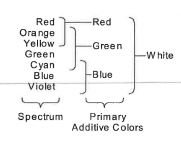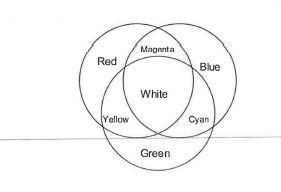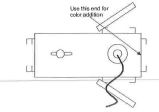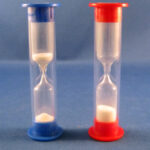Color Addition
Subject: Physics
Grade Level(s): High School
Topic: Color
Big Idea(s):
- To learn the primary additive colors and how they add.
- To learn the complementary colors.
What you need:
- Light Box
- Power Supply
- Color Filters (Red, Green, Blue, Yellow, Cyan, Magenta)
Summary:
The spectrum formed in the previous lab showed many colors, but there are specific regions of interest. Figure 19 shows the colors, the regions of interest, and the overlap of the regions.
This figure suggests that white light is made up of red, green, and blue light and that other colors are the result of mixing various amounts of these three colors.
Primary Additive Colors
From the figure, you can see that red and green overlap to form yellow or orange. Green and blue overlap to form cyan. We can write this in short hand notation simply as
R+G ->Y
G+B ->C
(Orange is also made by combining red and green, but with a higher proportion of red to green.)
Notice that the red and blue regions of the spectrum do not overlap. The red is at one end (long wavelength) of the visible spectrum, and the blue is at the other end (short wavelength) of the visible spectrum. If we add these two colors, the result is a color that does not appear in the spectrum, magenta (hot pink).
R+B -> M
The three primary additive colors comprise the entire spectrum. If we add all three colors, the result is white.
R+G+B ->W
The combinations of the primary additive colors can be summarized with the
following diagram:
Complementary Colors
Complementary colors are two light colors that add together to produce white. Cyan is made of green and blue, so if red is added to cyan the result should be white. Cyan and red are complementary colors since they add to give white. The complementary colors are summarized below:
G + B – >C C + R = (G + B) + R -> W C and R are complementary.
R + G -> Y Y + B = (R + G) + B -> W Y and B are complementary.
R + B -> M M + G = (R + B) + G -> W M and G are complementary.
Notice that in the addition oflight summary figure (Figure 20), Rand Care opposite each other with W between. Each color in the figure is directly opposite its complement, with white in between.
Your students will use the light box and color slides to check the addition of complementary colors.
Learning Goals / Objectives:
- To learn the primary additive colors and how they add.
- To learn the complementary colors.
Background
A darkened room will make observations easier.
Use the end of the light box with the mirrored doors. Color filters are inserted in the three slots so that one color is projected out the end of the box, and one color is reflected in each mirror.
Color filters vary in quality. The filter that is placed in the end of the box (without the mirror) will be projected slightly stronger than the others. For instance, a strong red filter placed in the center slot may yield, instead of white light, a slightly red light. You may want to try different arrangements of filters to see which gives the best results. Also, students might mistake the cyan filter for either blue or green. Make sure they use the correct colors.
You may want to show students the color filters and have them learn the names of the colors before beginning this activity. Magenta and cyan will be important, and they may not be familiar with these colors.
Anticipatory Set:
• How do the primary additive colors combine?
• How do complementary colors combine?
Instructions / Activities:
- Plug the light box into the power supply. For this experiment, you will use the end of the light box with the swinging doors.
- Insert the red, green, and blue filters in the slots at the end of the light box, one on each side. You can turn off a side light by closing the door, and you can turn off the front light by inserting a mask.
- Turn on the power supply. Beams of colored light should be projected from the light box.
- Support your index card (or other screen) so that the colors can be projected onto it.
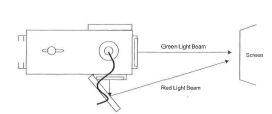
- Project the colors two at a time on the screen. Record the color that you see where they overlap.
Red + Green —>
Green + Blue —>
Red + Blue —> - Now add all three lights and record the color that forms where they all overlap.
Red + Green + Blue—> - Now add the following combination and record the color that forms.
Blue + Yellow —> - Explain the result of the last question. (Hint: What colors combine to produce yellow light?)
- Predict what will form with each of the following combinations. After you have made a prediction, use the color filters to try each combination and record the result.
Red + Cyan —>
Green + Magenta —>
Assessment:
Teacher’s Discretion
Wrap-up / Closure:
- The three primary additive colors are _ ____________ . They are called primary additive colors because they add up to give light.
- Complementary colors are two colors that add up to give white light. List three pairs of complementary colors.
- Complete each of the following light additions:
- Red + Green —>
- Green + Blue —>
- Red + Blue —>
- Red + Green + Blue —>
- Blue + Yellow —>
- Red + Cyan —>
- Green + Magenta—>
- Make a prediction about each ofthe following light additions. Hint: Write the primary additive colors that make up each color in the equation.
- Red + Green + Cyan —>
- Blue Green + Yellow —>
- Red + Blue + Yellow —>
- Red + Yellow —>
These materials are contained in a kit in our Library!
Tags: High School
Categories: Physics

